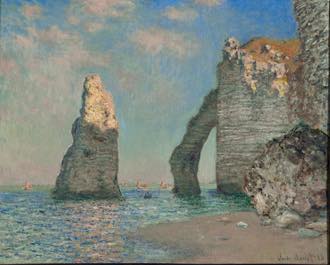
Seventy-one masterpieces of 19th-century French painting are making a rare visit to their original homeland. Until October 31, the crème de la crème of the illustrious Clark collection, which usually hangs in Williamstown, Massachusetts, is on display at the beautiful little Musée des Impressionismes in Giverny (just down the road from Claude Monet’s house and the water lilies).
While most of the paintings in the show are signed by famous Impressionists (Renoir, Monet, Degas, Manet, Morisot, Sisley, Pissarro), they are juxtaposed with works by Corot, Millet and Théodore Rousseau of the earlier Barbizon school and contrasted with showy academic compositions by Bouguereau and Gérome. Post-Impressionism appears at the end with Toulouse-Lautrec, Bonnard and Gauguin.
The breathtaking ensemble reflects the eclectic and opinionated tastes of American millionaire Sterling Clark (1877-1956) and his French wife, Francine (1876-1960), the collectors who acquired most of these works between 1910 and 1950. Heir to the Singer sewing-machine fortune and a charismatic character with an adventurous spirit, Clark grew up in luxury in New York among Old Masters collected by his mother. After a stint in the Army and an expedition to China, he moved to Paris in 1910, buying a mansion near the Arc de Triomphe and setting out to fill it with art.
He was soon sharing his quest with the woman he loved, the lively and charming Francine Clary, an actress with the Comédie Française who appeared with Sarah Bernhardt during her career. The New York bon vivant and the dressmaker’s daughter lived together (with her child from a previous liaison), bought paintings together and finally married in 1919, despite the Clark family’s unrelenting disapproval.
Clark’s passion for Impressionism began with Renoir’s “A Girl Crocheting,” which he purchased in 1916. It was the first of 39 works he bought by his favorite artist, whom he considered an unequaled colorist, rivaling Titian. Renoir is the undisputed star of the exhibition in Giverny, with 21 canvases. Several depict the ingénues both Renoir and Clark favored as subjects, notably “At the Concert,” “Blonde Bather” and “Sleeping Girl with Cat.”
Besides comely young women, clothed or nude, the Clarks liked luminous landscapes (like Monet’s “Spring in Giverny” and Pissarro’s “Saint-Charles, Eragny”) and other rural scenes. Degas’ “Before the Race” reflects Sterling’s interest in horses (he had a stud farm in Normandy. and one of his thoroughbreds won the Epsom Derby in 1954). Yet of all his paintings, Clark is said to have been most fond of Renoir’s simple, unpretentious and exquisite still life “Onions.”
The Clarks liked to say that they loved art of all kinds, as long as it was the best of its kind. Clark was a self-made art expert and, despite his enthusiasm for the innovative Impressionists, was more conservative than avant-garde. There are no Cézannes in the collection, as Clark considered him too modern. And this is what he wrote about Picasso and Matisse in 1934: “Dreadful – I would not give $10 apiece for them.”
As for Francine, described by Clark as “an excellent judge” of painting, she approved every major purchase. Her own tastes seem to have been influenced by her stage experience; it was she who convinced her husband to buy the Toulouse-Lautrec portrait of Moulin Rouge dancer Jane Avril.
Sterling and Francine Clark had no children together. Their life-long romance produced the art collection – which numbered upward of 5,000 items (including sculpture, drawings, photography, etc.) at the end of World War II – and also the Sterling and Francine Clark Art Institute, which they built in Williamstown in the 1950s. Because the institute is being refurbished at the moment, its finest paintings are traveling the world until 2013.
The Clarks believed that art was best viewed in a natural setting, and the bucolic surroundings of Giverny provide the ideal showcase for their treasures.
Favorite